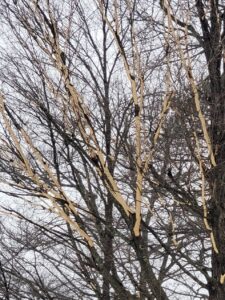By Linda Williams, Forest Health Specialist, Woodruff, Linda.Williams@wisconsin.gov or 920-360-0665

Squirrels remove the bark of maples, leaving bright bare spots. Photo: Wisconsin DNR
It’s the time of year when we start to see scattered maple trees stripped of their bark. Squirrels cause this damage — which can be limited to a few small areas the size of a tennis ball or can extend to cover many feet of branches or the main stem.
The squirrels are going after the cambium layer, just under the bark, that tastes slightly sweet from the sap. Smooth bark is easier for squirrels to chew, so young trees or branches with thin bark are likelier to be stripped than those with older, furrowed bark.
At this time of year, the pale wood of the branches that have had the bark stripped off is nearly white; later in the season, this wood will darken or even turn black with sooty mold. This type of feeding can remove enough bark to girdle the branches or the main stem, causing the tree to die from that point to the end of the branch.
Branches that are not completely girdled will continue to grow, and callus tissue will begin to grow over the wounds. If branches are nearly girdled, they may leaf out this spring and then suddenly wilt and die as hot weather hits because the tree can’t deliver enough water to keep those leaves alive.
Squirrels aren’t the only animals that will strip bark off portions of our trees. Porcupines will de-bark both hardwoods and conifers. If you’re trying to decide what animal caused the damage, look closely at the size of the tooth marks where the bark was scraped off the tree. The size of the tooth marks left in the wood is the key. For a gray squirrel, the incisor widths vary from 1.3-1.7 millimeters; for a porcupine, it’s nearly triple that, about 3.6-4.8 millimeters.
Rabbits can cause similar tree damage wherever they can reach, and with some areas of the state having up to 3 feet of snow on the ground at varying times this winter, rabbits may strip the bark from trees higher than you might expect.
Mice and voles can also chew off bark, but they often live under the snow in the winter and will girdle trees and shrubs near ground level.
The University of Wisconsin-Extension has a brochure about tree squirrels, including control options that can include protecting the trees or removing the squirrels.
If you have regional or site-specific questions on this issue, please contact your regional Forest Health Specialist.
